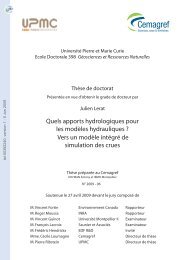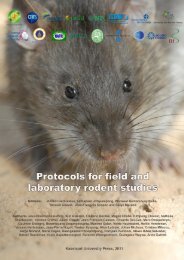Impact des métaux lourds sur les interactions plante/ver de terre ...
Impact des métaux lourds sur les interactions plante/ver de terre ...
Impact des métaux lourds sur les interactions plante/ver de terre ...
You also want an ePaper? Increase the reach of your titles
YUMPU automatically turns print PDFs into web optimized ePapers that Google loves.
Partie C : Résultats – Chapitre C-IThis study shows that the efficiency of L. camara phytoextraction <strong>de</strong>pends on theconcentration of lead in the soil. Similarly, the Zn uptake by T. caeru<strong>les</strong>cens increasedlinearly according to Zn concentration in the 1-1000 mmol m -3 range, but concentrationsgreater than 1000 mmol m -3 resulted in toxicity and <strong>de</strong>creased Zn uptake (26). In this study,the total lead values (shoot and root) and the shoot-to-root lead concentration ratio werehigher at 1000 mg Pb kg -1 than those at 500 mg Pb kg -1 . This result suggested that, even at thishigher concentration, lead was favorable for the growth of L. camara.tel-00486649, <strong>ver</strong>sion 1 - 26 May 2010Although the abundance of earthworms in the microcosms was higher than the a<strong>ver</strong>ageabundance of 20 g.m -2 observed in the field (27) and a little lower than the 127 g.m -2 used forMillsonia anomala by Blouin et al. (28), after one month, most of the earthworms were stillalive (> 90%) and the soils had been completely burrowed by earthworms. This indicated thatP. corethrurus had a high tolerance to lead ions in these experimental conditions. Thistolerance could be due, as suggested by Morgan et al. (14), to the ability of earthworms toaccumulate metal in their tissues and to <strong>de</strong>toxify using mechanisms such as binding andstoring the lead in metallothionein.In uncontaminated soils, the effect of earthworms on the plant growth was notsignificant. Howe<strong>ver</strong>, se<strong>ver</strong>al mechanisms by which earthworms modify plant growth directlyand indirectly have been studied. Blouin et al. (28) <strong>de</strong>termined five reasons which could beinvoked to explain the positive effects of earthworms: (i) increased mineralization of organicmatter in the soil, increasing nutrient availability (e.g. phosphorus availability), (ii)modification of the soil structure to change water and oxygen availability for plants, (iii)production of plant growth stimulating microorganisms, (iv) dispersal of microorganismsantagonistic to root pathogens and (v) stimulation of symbionts. The lack of effect on thegrowth of L. camara in the presence of P. corethrurus could be explained by the absence ofpathogens in this experiment, the special metabolism of the plant that makes it useful forremediation and the low volume pots that could limit beneficial effect of earthworms on soilstructure.In the microcosms contaminated with lead, the presence of P. corethrurus resulted inincreased shoot and root biomass as well as increased lead uptake by P. corethrurus. Theseresults agreed with those of Wang et al. (18) who reported increased Zn phytoextraction byryegrass and Indian mustard when the soil was inoculated with the earthworm Pheretima sp.62
















